Comparison of Bathtub Materials: Which is Best for Your Bathroom?
Introduction
Understanding the characteristics of various bathtub materials is essential for anyone looking to enhance their bathroom design with bathtub.
This article compares 10 different bathtub materials, examining what each material is, how it's molded, and its pros and cons.
We’ll also delve into the visual, tactile, and testing aspects of each material.
By committing to this comprehensive comparison, you’ll gain a better understanding of these materials, helping you make an informed decision for your bathroom.
Whether you're worried about durability, aesthetics, or cost, this guide will help you navigate the complexities of bathtub materials and solve your specific problems.
Material Comparison
Weight:
Material/level | Light | Medium | Heavy |
Acrylic | √ |
|
|
Fiberglass | √ |
|
|
Enamel-Coated Steel |
|
| √ |
Cast Iron |
|
|
|
Stone Resin |
| √ |
|
Solid Surface |
| √ |
|
Copper |
|
| √ |
Wood |
| √ |
|
Solid Surface Resin |
| √ |
|
Ceramic |
|
| √ |
Price:
Material/level | Low | Medium | High |
Acrylic |
| √ |
|
Fiberglass | √ |
|
|
Enamel-Coated Steel |
| √ |
|
Cast Iron |
|
| √ |
Stone Resin |
|
| √ |
Solid Surface |
| √ |
|
Copper |
|
| √ |
Wood |
|
| √ |
Solid Surface Resin |
|
| √ |
Ceramic |
| √ |
|
Durability:
Material/level | Durable | Very Durable | Maintenance Required |
Acrylic | √ |
|
|
Fiberglass |
|
| √ |
Enamel-Coated Steel |
| √ |
|
Cast Iron |
| √ |
|
Stone Resin |
| √ |
|
Solid Surface |
| √ |
|
Copper |
| √ |
|
Wood |
|
| √ |
Solid Surface Resin | √ |
|
|
Ceramic |
| √ |
|

Acrylic Bathtub
What it is:
Material: Acrylic bathtubs are made from a polymer called methyl methacrylate (MMA).
Production: The production process involves pouring a liquid acrylic mixture into a mold, curing it, and then polishing it to form a strong acrylic sheet.
This sheet is subsequently cut and thermoformed into the shape of a bathtub.
Advantages and Disadvantages:
Advantages:
- Affordable and offers good thermal insulation.
- Lightweight, making it easy to install and carry.
- Resistant to weather and UV rays, preventing discoloration and aging.
- Easy to process, allowing for a variety of shapes and colors.
- Smooth surface makes cleaning and maintenance convenient.
Disadvantages:
- May scratch or fade over time, and is not as durable as some other materials.
- Susceptible to scratches, which can affect its appearance.
How to Identify:
Visual: Uniform color with a smooth and glossy surface. Available in a wide range of colors and shapes.
Touch: Warm and smooth to the touch, even in colder rooms. When tapped, it produces a duller sound.
Weight: Lightweight and easy to handle.
Test: Tap on the surface; it should sound hollow. The material is soft and may leave marks when lightly scratched.

Fiberglass Bathtub
What it is:
Material: Fiberglass bathtubs are made from a combination of glass fiber and resin, typically polyester resin.
Production: The production process involves laying fiberglass fabric into a mold, coating it with resin, and then laminating and curing it to form the bathtub.
The finished product is polished for a smooth surface.
Advantages and Disadvantages:
Advantages:
- Lightweight, making it easy to install.
- Good water resistance and not prone to deformation from moisture.
- Can be repaired if damaged.
- Relatively inexpensive compared to other materials.
Disadvantages:
- The surface is easily scratched and requires regular maintenance.
- Less durable, with potential for scratches and cracks.
- Colors may fade over time.
- Low-quality fiberglass products may have burrs.
How to Recognize:
Visual: Smooth surface that is thinner and more pliable than acrylic. The surface may appear darker, and you might see fiber textures or tiny air bubbles, usually in white or light colors.
Touch: Warm to the touch and slightly more flexible than acrylic. Generally smooth but may have slight roughness in places.
Weight: Lightweight.
Test: Tap the surface; it should produce a slight hollow sound. Look for signs of discoloration or surface cracking; light scratches may leave marks.

Enamel-Coated Steel Bathtub
What it is:
Material: Enamel-coated steel bathtubs are made from a steel plate coated with enamel.
Production: The steel plate is stamped and shaped, then a layer of enamel is applied to its surface.
The piece is fired at high temperatures to fuse the enamel with the steel, creating a hard, smooth surface.
Advantages and Disadvantages:
Advantages:
- Sturdy and durable with high hardness, making it resistant to scratches.
- Excellent chemical corrosion resistance due to the enamel coating.
- High gloss and smooth, bright appearance.
- Relatively inexpensive compared to some other high-end materials.
Disadvantages:
- Heavy, making installation difficult and requiring strong support.
- If the enamel coating is damaged, it can chip and rust.
- Poor insulation compared to acrylic or cast iron, leading to quicker cooling of bathwater.
How to Recognize:
Visual: High-gloss surface, typically in white or pink. The surface looks smooth and polished.
Touch: Cool to the touch with a very smooth and glossy surface. Feels hard and cold, usually in pure white or other monochromatic colors.
Weight: Heavier than acrylic or fiberglass but not as heavy as cast iron.
Test: Using a magnet; the magnet will stick to the steel beneath the enamel. Produces a crisp sound when tapped and is hard, not easily scratched.
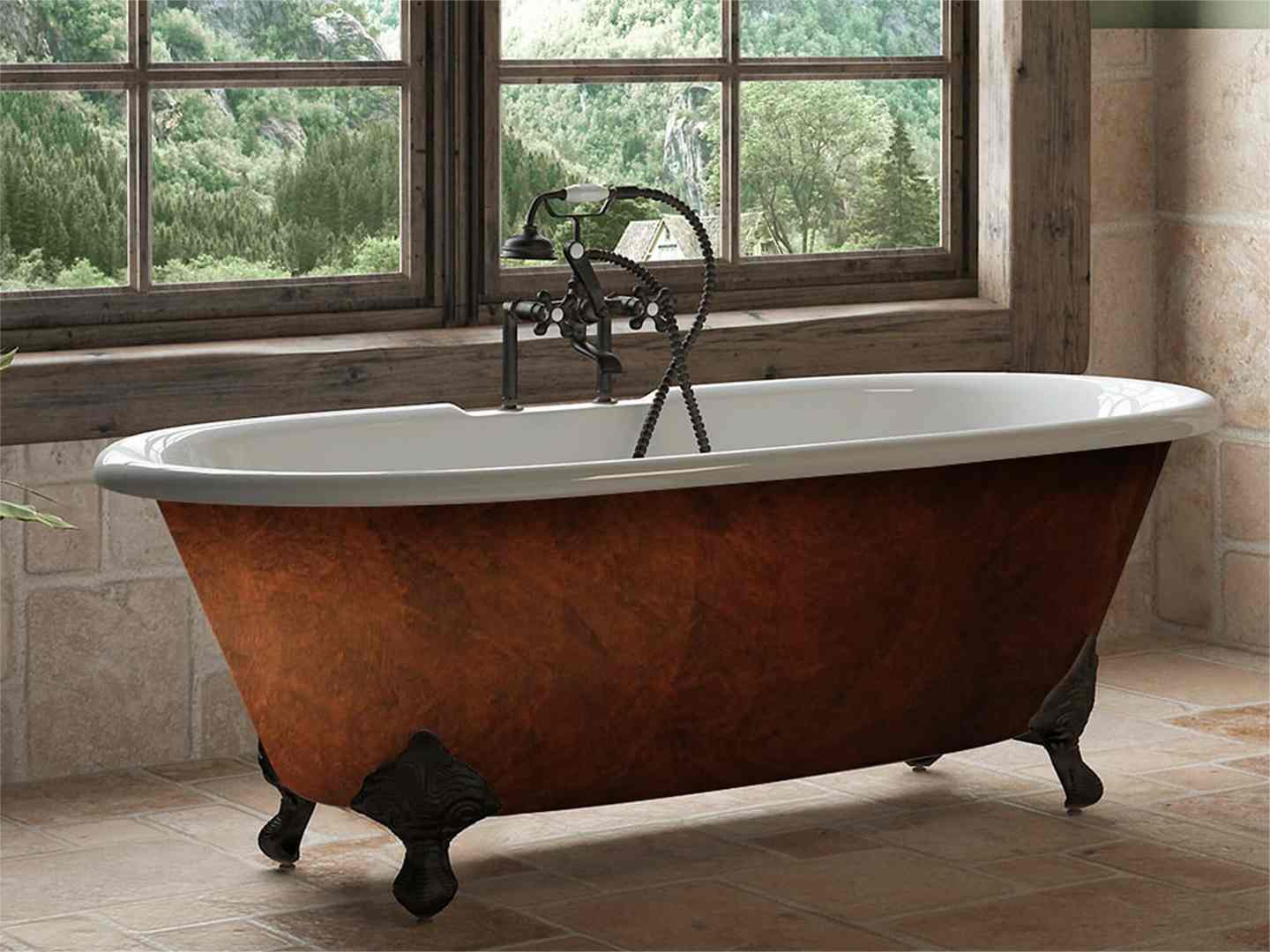
Cast Iron Bathtub
What it is:
Material: Cast iron and enamel.
Production: Melted iron is poured into molds for casting and shaping.
After cooling, the surface is coated with porcelain enamel and then fired at high temperatures, fusing the enamel with the cast iron to form a durable surface.
Advantages and Disadvantages:
Advantages:
- Extremely durable and resistant to scratches and chips.
- Long service life, often lasting decades.
- Excellent thermal insulation, maintaining water temperature for longer periods.
- Classic and elegant appearance, offering a traditional upscale feel.
Disadvantages:
- Very heavy, making installation difficult and requiring sturdy floor support.
- More expensive compared to many other materials.
How to Recognize:
Visual: High-gloss finish with a very smooth and shiny surface, typically in white or other monochromatic colors.
The edges and bottom appear very solid and robust.
Touch: Extremely smooth, hard, and cold to the touch. When tapped, it produces a dull and steady sound.
Weight: Extremely heavy, making it difficult to lift and maneuver.
Test: Tap on the surface; it should produce a dull, solid sound. Using a magnet, it will stick to the iron beneath the enamel.
The surface is very hard and not easily scratched.
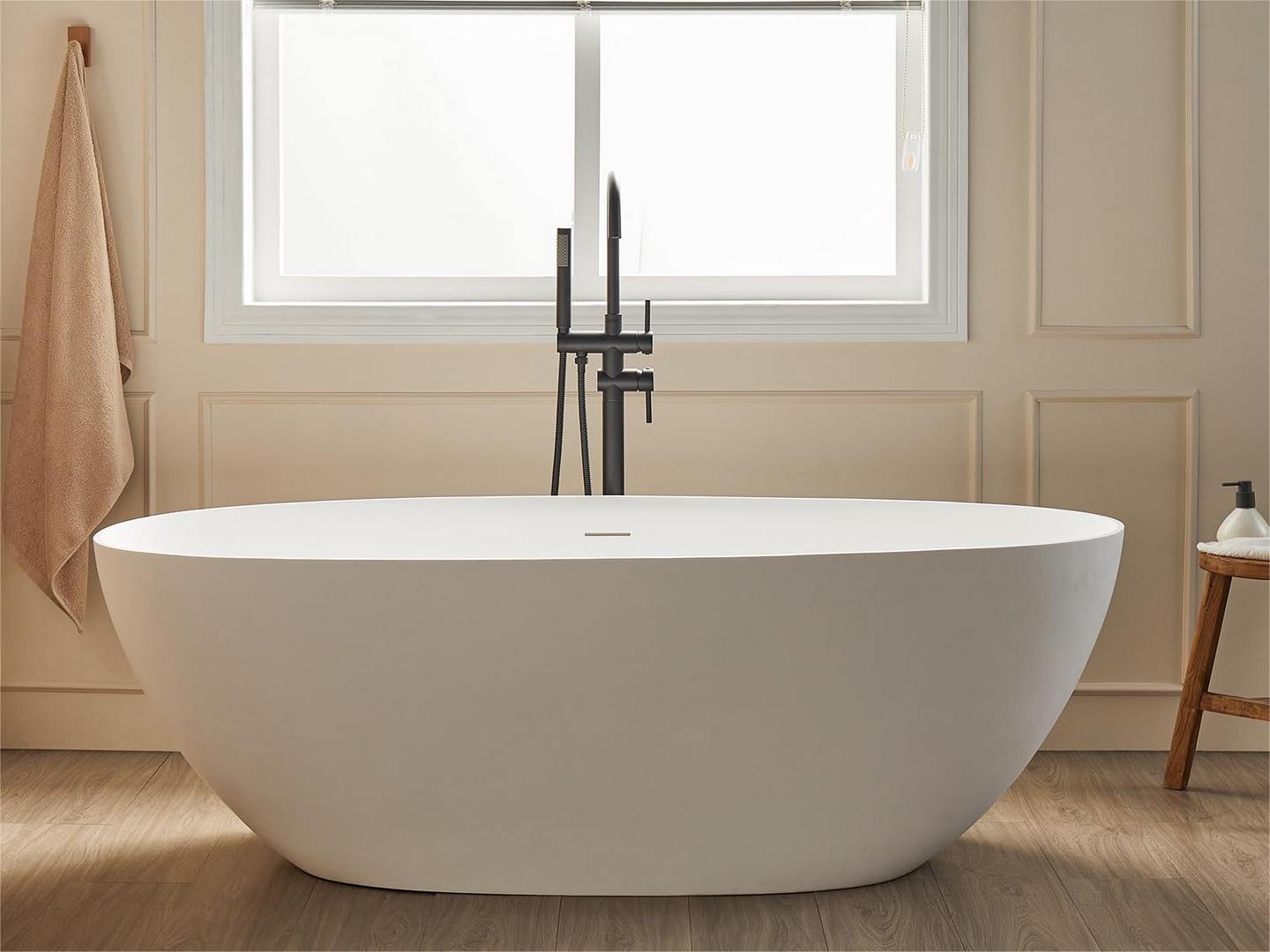
Stone Resin Bathtub
What it is:
Material: Stone resin bathtubs are made from a mixture of natural stone powder and resin, typically polyester resin.
Production: The stone powder and resin are mixed and poured into molds, where they are cured and shaped.
After curing, the surface is polished and coated to achieve a smooth finish.
Advantages and Disadvantages:
Advantages:
- Highly durable and resistant to scratches and stains.
- Excellent thermal insulation, keeping hot water warm for extended periods.
- Luxurious appearance with a high-grade look, resembling the texture and appearance of natural stone.
- Non-porous and mold-resistant, making it easy to clean and maintain.
Disadvantages:
- Heavier than many other materials, requiring professional installation and consideration of floor load-bearing capacity.
- Higher cost compared to ordinary materials.
How to Recognize:
Visual: The surface can be either matte or glossy, with a texture similar to natural stone.
The color is uniform and can come in various shades and patterns.
Touch: Hard and smooth with a certain warmth to the touch.
When tapped, the sound is duller compared to more hollow materials.
Weight: Heavy and solid.
Test: Tapping the surface should produce a solid, not hollow sound.
The material is hard and not easily scratched.
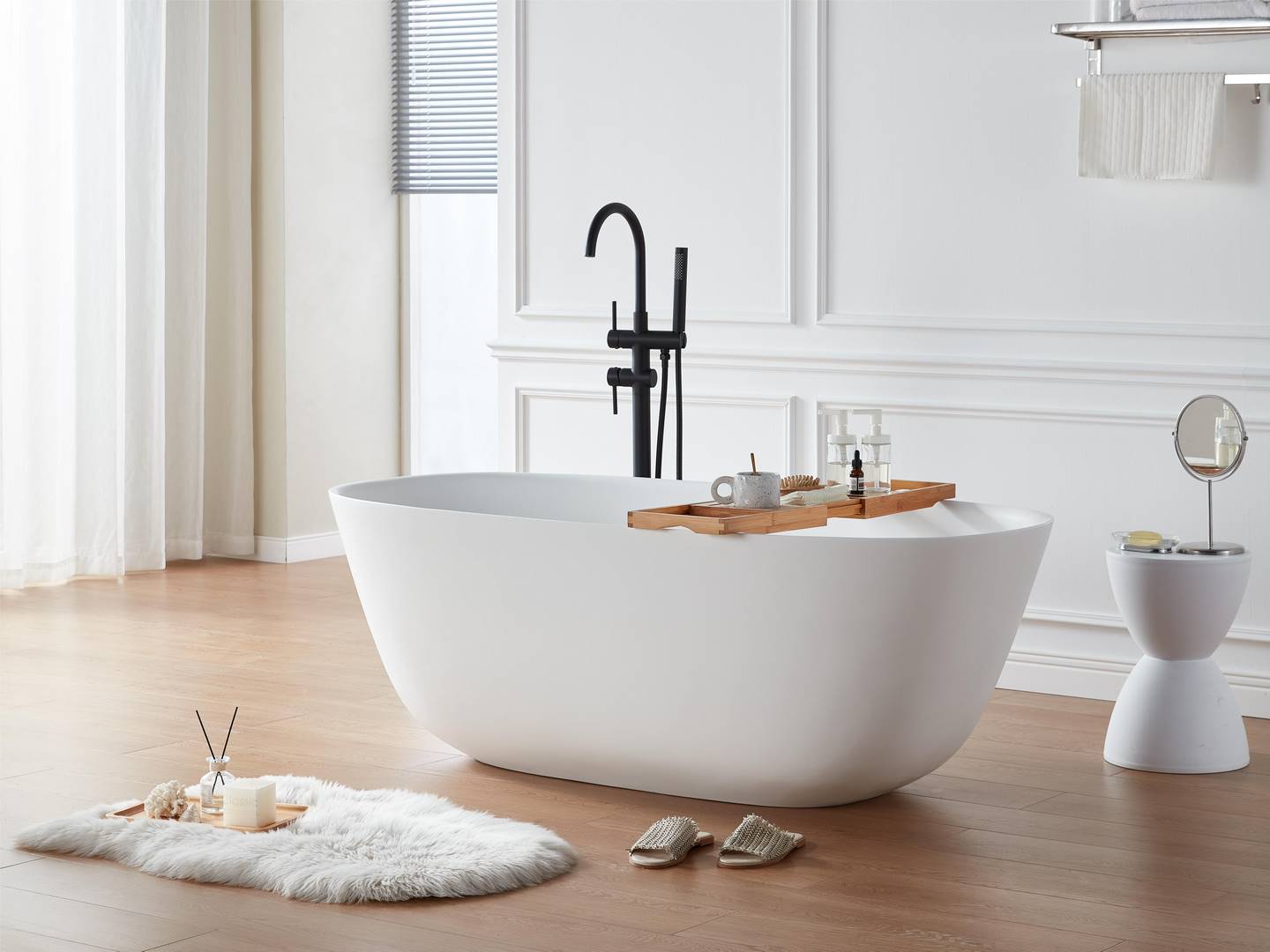
Solid Surface Bathtub
What it is:
Material: Solid surface bathtubs are made from a blend of aluminum hydroxide (ATH), polyester resin, and pigments.
Production: The mixture is poured into molds to solidify into shape, followed by a process of cutting, sanding, and polishing to create the finished tubs.
Advantages and Disadvantages:
Advantages:
- Highly durable with good thermal insulation.
- Seamless design, can be made to look like a single, continuous piece.
- Waterproof, easy to clean, and maintain.
- Easy to repair; surface scratches and damage can be fixed by sanding.
- Versatile, with a wide range of colors and styles, and can be molded into various shapes.
Disadvantages:
- Expensive, often requiring professional installation.
- May stain and therefore requires regular cleaning and maintenance.
- Mid-range price, slightly higher than average materials.
How to Recognize:
Visual: Available in a variety of colors and finishes, with a uniform color and texture. The surface is smooth with a subtle sheen and can be designed to appear seamless.
Touch: Smooth and warm to the touch, with a dull sound when tapped.
Weight: Medium weight.
Test: Tapping the surface should produce a solid, non-hollow sound. The material is softer, and light scratches may leave marks.

Copper Bathtub
What it is:
Material: Copper bathtubs are made from pure copper sheet or copper alloy.
Production: The production process involves molding copper sheets through handcraft or mechanical methods such as hammering, welding, and polishing.
The final step includes surface treatment to enhance corrosion resistance.
Advantages and Disadvantages:
Advantages:
- Excellent thermal insulation, keeping bathwater warm for longer periods.
- Antibacterial properties; copper's natural antimicrobial qualities help maintain hygiene.
- Unique and luxurious appearance, with a classic and distinctive look.
- Good durability, with a long service life, and will develop a distinctive copper green patina over time.
Disadvantages:
- Very expensive, costing more than most other materials.
- Heavy, making installation more difficult.
- Requires regular maintenance, including polishing, to keep its luster.
How to Recognize:
Visual: Copper bathtubs have a unique metallic appearance, usually with a patina.
Newer copper tubs are shiny, while older ones may have a greenish patina. They may also feature hammered or carved textures.
Touch: Hard and cold to the touch with a distinctive metallic feel. When tapped, they produce a crisp, metallic sound.
Weight: Medium to heavy weight.
Test: The copper color is apparent and may develop a patina over time.
The material is softer than steel, and light scratches may leave marks but can be harder than other softer materials.

Wooden bathtub
What it is:
Material: Wood bathtubs are typically crafted from various hardwoods, such as cedar, mahogany, or teak.
Production: The wood is first treated to be waterproof.
The boards are then spliced together, sanded, and given a coating treatment to form the bathtub.
Advantages and Disadvantages:
Advantages:
- Offers natural beauty and good heat retention, creating a warm and inviting feel.
- Provides a unique and luxurious appearance, with high customizability.
- Natural wood brings a sense of warmth and tranquility to the bathroom.
Disadvantages:
- Can be very expensive, depending on the type of wood and craftsmanship.
- Susceptible to moisture and deformation, requiring special treatment to prevent mold and water damage.
- High maintenance costs due to the need for regular upkeep and treatment to prevent corrosion.
How to Recognize:
Visual: The natural grain and tone of the wood are visible, often with a coated sheen that enhances its natural beauty.
The wood’s unique grain patterns and colors can be clearly seen.
Touch: Warm to the touch with the distinctive texture of natural wood. When tapped, it produces a dull, soft sound.
Weight: The weight varies depending on the species of wood used.
Test: Obvious wood characteristics such as grain patterns are apparent.
The material is softer compared to metals and may leave marks when lightly scratched.

Solid Surface Resin Bathtub
What it is:
Material: Solid surface resin bathtubs are made from a mixture of aluminum hydroxide, polyester resin, and pigments.
Production: Similar to solid surface bathtubs, the mixture is poured into a mold to cure and form the tub. The tub is then made through a process of cutting, sanding, and polishing.
Advantages and Disadvantages:
Advantages:
- Seamless designs, making them easy to clean and aesthetically pleasing.
- Available in a wide range of colors and textures.
- Easy to repair; minor scratches and damage can be sanded and fixed.
- Provides a modern and sleek appearance suitable for various bathroom designs.
Disadvantages:
- Moderately expensive, slightly more costly than common materials.
- Average heat resistance, which means super-high temperature exposure should be avoided.
How to Recognize:
Visual: The color and texture are usually uniform, with various colors and patterns available.
The surface is smooth with a certain gloss, although not extremely shiny. Seamless design is common, with smooth, neat edges and no visible seams.
Touch: Warm to the touch and not particularly cold. The surface feels smooth and slightly soft, with a bit of flexibility.
Test: When tapped, it produces a dull sound similar to knocking on plastic.
Light scratches from a hard object may leave marks but can be repaired by sanding. Pouring hot water on the surface may cause slight deformation or softening.
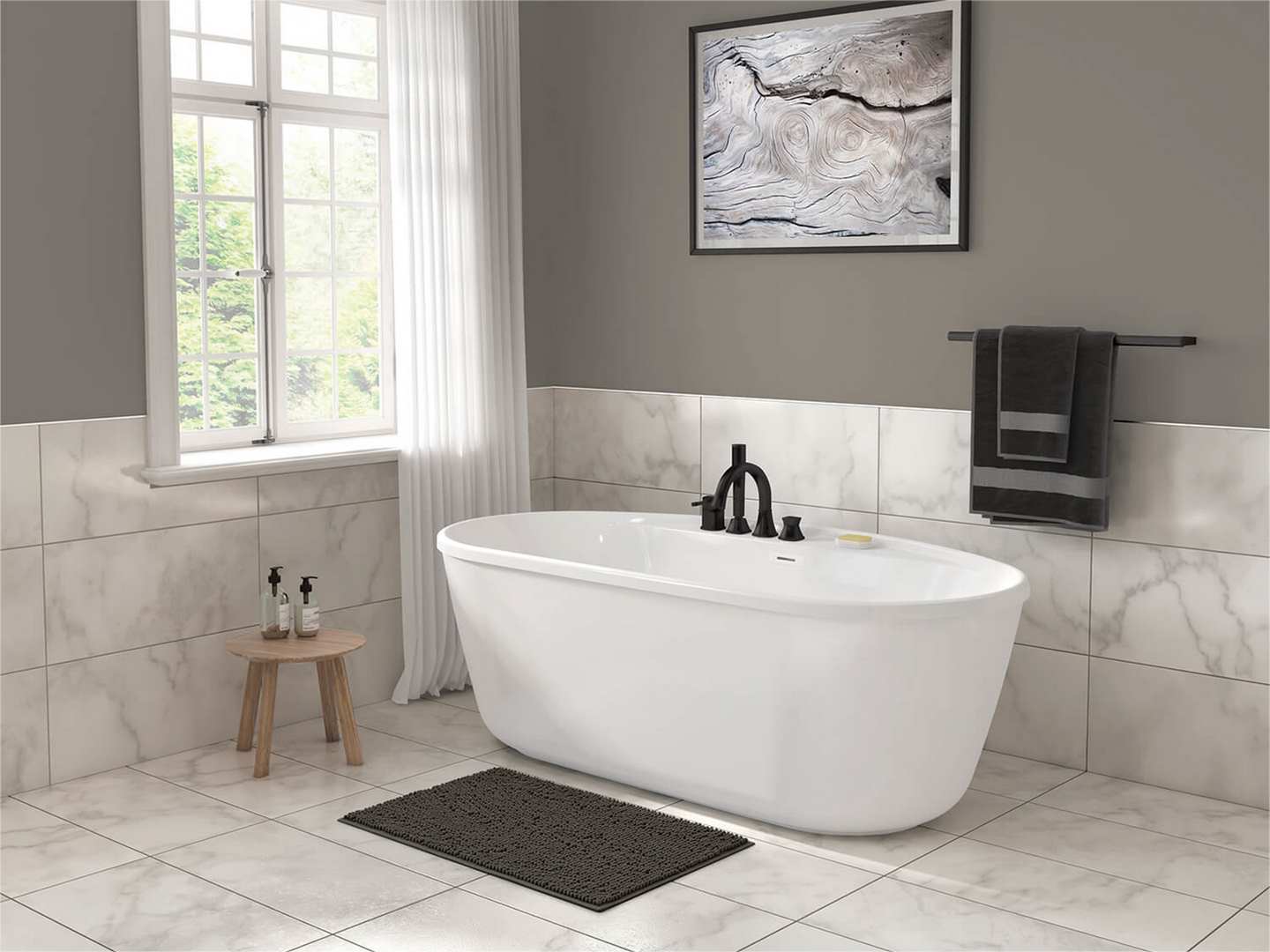
Ceramic Bathtub
What it is:
Material: Ceramic bathtubs are made from clay and enamel.
Production: The clay is shaped into porcelain blanks through molding and high-temperature firing.
The surface is then coated with porcelain enamel and fired again at a high temperature to create a smooth and durable ceramic surface.
Advantages and Disadvantages:
Advantages:
- Highly durable and hard, making it resistant to scratches.
- Easy to clean due to its smooth surface that doesn't easily hide dirt.
- Available in a wide range of rich colors and patterns.
Disadvantages:
- Fragile and can easily crack or rupture if hit hard.
- Heavy, requiring consideration of load-bearing capacity during installation.
How to Recognize:
Visual: Pure, smooth, and high-gloss surface with an obvious reflective effect under light.
Colors and textures are uniform, often with a natural ceramic texture.
Seams may be slightly visible, especially at splicing points, and edges can be a bit rough.
Touch: Cold to the touch, particularly noticeable in winter.
The surface is very smooth and hard with no flexibility.
Test: Tapping it produces a crisp sound, similar to knocking on porcelain.
It resists light scratches from hard objects, but excessive force can cause breakage or chipping.
It has good heat resistance; pouring hot water on the surface causes no changes.
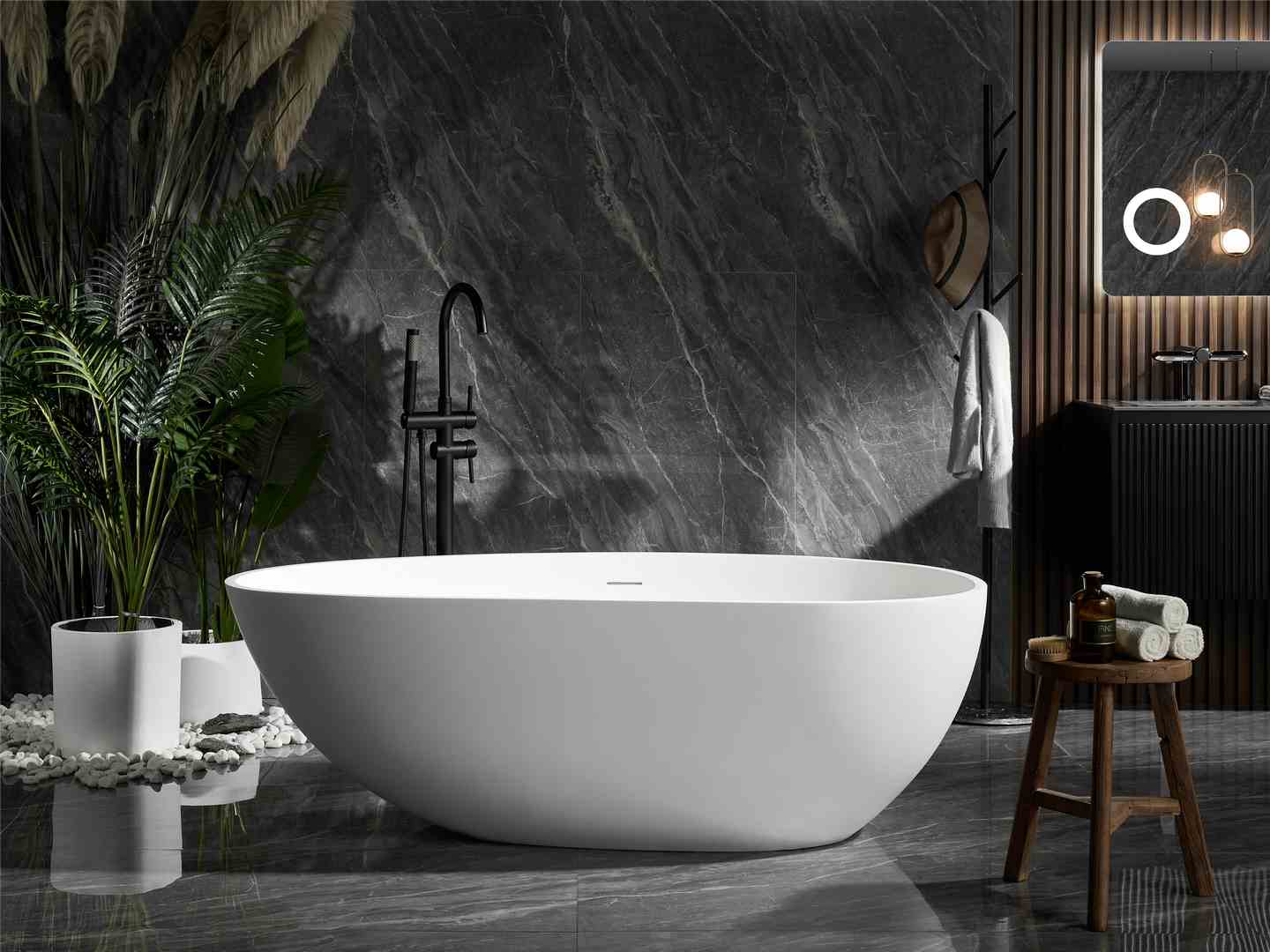
Conclusion
This article has provided a detailed comparison of 10 different bathtub materials: acrylic, fiberglass, enamel-coated steel, cast iron, stone resin, solid surface, copper, wood, solid surface resin, and ceramic.
Each material has its unique advantages and disadvantages, offering solutions to various needs and preferences.
Whether you prioritize durability, thermal insulation, aesthetic appeal, or ease of maintenance, this guide helps you identify the right material for your bathroom design.
By understanding these comparisons, you can make an informed decision that balances functionality, cost, and style, ensuring your bathtub meets both practical and personal requirements.
Welcome to know more detailed information about products in Cpingao:
